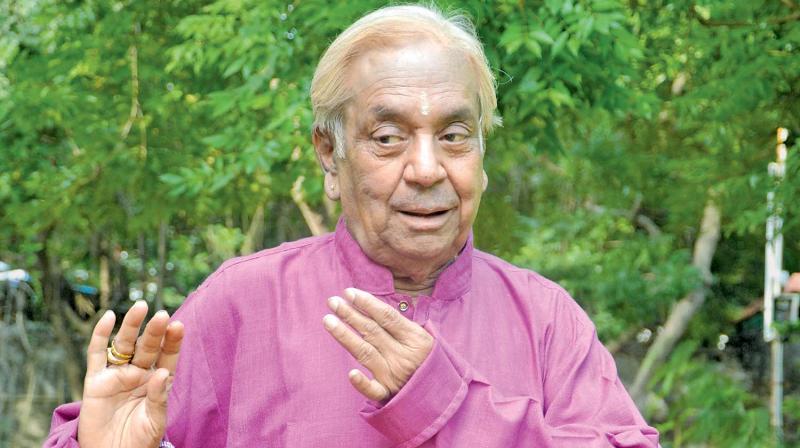Guru believes in purity of traditional Kathak

Mehfil e Kathak’ brings to the city an eclectic Kathak presentation by India’s prominent Kathak dancers as a tribute to India’s Kathak maestro Pandit Birju Maharaj. A three-day long dance workshop was also held by Maharaj and Vidhushi Saswati Sen for the city’s Kathak lovers and aspiring students. The mehfil is expected to enthral the audience with performances by Durga Aryaji, Mayur Vaidya and Group, Vishal Krishna and Neha Banerjee from Kathak Darpan. The mehfil will be staged this evening at Rukmini Arangam in Kalakshetra Foundation.
Choreographing Kamal Haasan during the shooting of Vishwaroopam is one of Birju Maharaj’s prominent memories. “Kamal imbibed the Kathak steps wonderfully, but then he is a good Bharatanatyam dancer”, Maharaj shared cheerfully while speaking on his experience of teaching him during Vishwaroopam days. He also shared a small session of choreography for Vishwaroopam 2 capturing childhood scenes of the character portrayed by the actor. “I’ll be very happy if Kamal plans any of his future choreography with me,” says Maharaj.
The tradition of his gharana is what Maharaj upholds in the workshop while transmitting the beauty of a unique dance style through expressions and body gestures. He wants to share the art with young dancers. Brijmohan Nath Mishra, a.k.a. Birju Maharaj, talks to DC about his passion- dance and today’s contemporary forms of Kathak.
Elaborate on your dance gharana, ‘Kalka-Bindadin’ recognised as ‘Lucknow gharana’
Kathak was the dance form which used tales that were expressed through various gestures or ‘bhav’s. The six-generation old gharana ‘Kalka-Bindadin’ belongs to Lucknow’s Handia tehsil ‘Kichkira’ village, where people started ‘dance steps formed from ‘katha’ or words.’ One ‘sadhu’ in the village used to cook khichdi for all and used to distribute it in ‘handis’ among the people, which is how the name came out as Handia from the village Haripur. The 980 households (kathak dancers’ families) that can trace their origins to the sultanate era used to sing, dance or engage themselves in different cultures. They practised such a format of dance with folklores on Ram-Sita’s stories during festivals like Diwali, Dusshera and at fairs. But they never used to travel across India before the families moved to different parts of UP like Azamgarh or Kashi due to some calamity.
How would you define Kathak to someone who hasn’t heard of it?
The dance styles are like that of a child who comes to earth and by default cries as nobody prompts him or her how to cry. Gradually, he/she starts taking on mischievous attitudes and learns other activities while growing up (expressions) imbibing from the atmosphere. The time taken for the child to adopt those is rhythms. That’s how it is.
What sets your gharana different from the others?
‘Saundarya’ or beauty is dominant in this gharana of dance along with dramatism and ‘bhav’ (expression). This style of dancing has been originated from nature, reflecting expressions from nature and also reflecting ‘Lucknow ki Tehzeeb’ or Nawabi etiquettes which my father Achhan Maharaj, uncles Lachhu Maharaj and Shambhu Maharaj trained me-their little ‘Maharaj’ at the tender age of three and a half.
What would be your reaction to the fusion of classical dance forms with contemporary forms?
I don’t believe in fusions, I’m completely against it. Fusion comes to the mind of a choreographer as a need for bridging the gap or the lack of dancing styles. But our tradition is so rich, its purity and uniqueness doesn’t need to be mixed with something else. I have worked on lots of contemporary styles but in my own way while keeping the tradition intact.
Apart from dance, what else interests Maharaj?
Since childhood I wanted to be a mechanic. I never used to ask my ‘Amma’ to purchase clay toys for me, I always asked for iron ones because they were hardy enough to last longer. I used to do some paintings too.
Which one is the best choreography of yours till date?
My favourite has always been Madhuri in Devdas and the choreography in the movie. Most of all, ‘Sanjay ji’ (Sanjay Leela Bhansali) always understands me, so we can collaborate better.
What would be your advice for the aspiring young dancers?
Youngsters these days call mere movements and exercises dancing but in actual dancing is so much more. My secret of dance is to transmit all of my feelings to the audience though my expressions and movement.
How important is discipline in a dancer’s life?
When you are a dancer you are a ‘saadhak’ or
practitioner, then you have to give up some attitudes, some bad habits and
follow the rules of practice.

